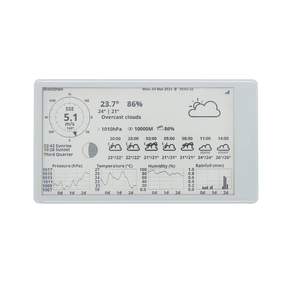
LilyGo T5 4.7 Inch E-Paper V2.3 is a development board based on the ESP32 microcontroller using XTENSA architecture.
This board features a maximum CPU frequency of 240 MHz and 16MB flash memory.
About LilyGo T5 4.7 Inch E-Paper V2.3
🚀 The LilyGo T5 4.7 Inch E-Paper V2.3 is an ESP32-based development board designed for ultra-low-power applications. It features a 4.7-inch e-paper display with crisp monochrome visuals, making it ideal for e-book readers, IoT dashboards, and battery-powered projects. ⚡
📡 Equipped with WiFi 802.11 b/g/n and Bluetooth 4.2, the board allows seamless wireless communication. It comes with 8MB PSRAM and 16MB Flash for handling complex data processing and image rendering.
💾 Designed for energy efficiency, the T5 supports deep-sleep modes, optimizing battery life for long-term usage in IoT applications.
LilyGo T5 4.7 Inch E-Paper V2.3 Technical Specifications
🖥️ Display
🔌 USB
🛰️ Connectivity
🧠 Microcontroller
✨ Features
- 48 digital IO pins
- 46 external interrupt pins
- 20 analog input pins
- 27 PWM pins
LilyGo T5 4.7 Inch E-Paper V2.3 Pinout

Safe Pins to Use
For general GPIO usage, these are the safest and most flexible choices:
Why Are These Pins Safe?
- • Not involved in bootstrapping → No impact on device boot mode or system startup
- • Not linked to flash memory or PSRAM → Won't interfere with storage or memory access
- • Not dedicated to USB or JTAG → Free for general use without affecting debugging
- • No special hardware connections → Freely assignable without internal conflicts
Pins to Avoid or Use with Caution
Critical Pin Categories:
- Strapping Pins: Control boot behavior and flash voltage selection
- JTAG Debugging Pins: Required for low-level debugging
- USB Communication Pins: Used for USB Serial/JTAG communication
- Flash Memory & SPI Pins: Connected to SPI flash memory and PSRAM
- UART Serial Communication Pins: Used for debugging and firmware uploads
| PIN | Label | Reason | Function |
|---|---|---|---|
| IO1 | U0TXD (GPIO1) | Connected to on-board USB-UART for uploading and logs; drives serial output at boot, so using as GPIO can disrupt programming or console. | 🔌 USB |
| IO2 | GPIO2 | If driven HIGH on reset (while IO0 is LOW), selects an unsupported SDIO boot mode, causing boot failure. | 🛠️ Strapping |
| IO3 | U0RXD (GPIO3) | Used for receiving data from USB-UART (programming); also pulled HIGH at boot for console communication, so using as GPIO can disrupt uploads. | 🔌 USB |
| IO16 | GPIO16 | Connected to internal PSRAM on PSRAM-enabled modules; not usable as GPIO on those modules. | ⚡ Flash |
| IO17 | GPIO17 | Connected to internal PSRAM on PSRAM-enabled modules; not usable as GPIO on those modules. | ⚡ Flash |
LilyGo T5 4.7 Inch E-Paper V2.3 Useful Links
LilyGo T5 4.7 Inch E-Paper V2.3 Custom Pins
This development board provides 48 digital IO pins, out of which 46 can be used as external interrupt pins , 20 as analog input pins and 27 pins have Pulse-Width Modulation (PWM).
| Pin | Function | ESP Pin | Input/Output | Description |
|---|---|---|---|---|
| 1 | 3V3 | 3.3V | POWER OUTPUT | 3.3V power output |
| 2 | GND | GND | POWER GROUND | Ground connection |
| 3 | 5V | 5V | POWER INPUT | 5V power input |
| 4 | IO1 | GPIO1 | BIDIRECTIONAL | GPIO, ADC, I2C |
| 5 | IO2 | GPIO2 | BIDIRECTIONAL | GPIO, ADC |
| 6 | IO3 | GPIO3 | BIDIRECTIONAL | GPIO, ADC |
| 7 | IO16 | SPI_CS | BIDIRECTIONAL | GPIO, SPI Chip Select |
| 8 | IO17 | SPI_D | BIDIRECTIONAL | GPIO, SPI Data |
| 9 | IO18 | SPI_CLK | BIDIRECTIONAL | GPIO, SPI Clock |
| 10 | IO19 | SPI_Q | BIDIRECTIONAL | GPIO, SPI Q |
| 11 | IO21 | EPD_DC | OUTPUT | GPIO, E-Paper Data/Command |
| 12 | IO22 | EPD_RST | OUTPUT | GPIO, E-Paper Reset |
| 13 | IO23 | EPD_BUSY | INPUT | GPIO, E-Paper Busy Signal |
Default Tools for LilyGo T5 4.7 Inch E-Paper V2.3
| Bootloader tool | esptool_py |
| Uploader tool | esptool_py |
| Network uploader tool | esp_ota |
| Bootloader address | 0x0 |
| Flash mode | dio |
| Boot mode | qio |
| PSRAM type | opi |
| Maximum upload size | 3072 Kb (3145728 B) |
| Maximum data size | 320 Kb (327680 B) |
The LilyGo T5 4.7 Inch E-Paper V2.3 development board by default uses esptool_py uploader tool, network uploader tool for Over-the-air (OTA) uploads and esptool_py bootloader tool. The bootloader starts at address "0x0". Flash mode and boot mode for LilyGo T5 4.7 Inch E-Paper V2.3 development board by default is dio and qio respectively. The board uses opi PSRAM type. When using Arduino IDE, the maximum sketch upload size is 3072 Kb (3145728 B) and maximum data size for variables is 320 Kb (327680 B).
Similar Boards


